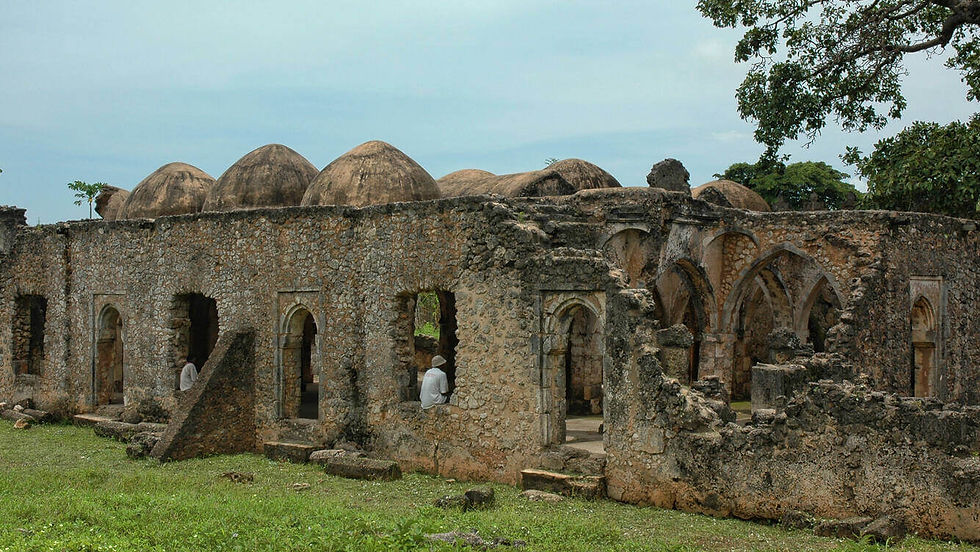Exploring 10 Ancient Ruins of Africa: Lesser-Known Historical Sites
- The blog nomad

- Sep 18, 2024
- 4 min read
Updated: Oct 10, 2024
Africa is home to some of the world's most mysterious and awe-inspiring ancient ruins, many of which remain lesser-known but offer deep insights into the continent’s rich past. These ruins are spread across countries and reflect the ingenuity of long-gone civilizations, making them ideal destinations for history enthusiasts and adventurers alike. Let's explore 10 of these hidden gems.
1. Engaruka Ruins – Tanzania
Engaruka in northern Tanzania features a complex system of terraced fields and stone structures that date back to the 14th century. It stands out for its advanced irrigation techniques, challenging conventional beliefs about ancient African societies. This archaeological site is a must-visit for those interested in pre-colonial agricultural practices.
Best time to visit: June to September (cooler weather)
Location: Near Arusha, Tanzania
2. Gedi Ruins – Kenya

The Gedi Ruins near the Kenyan coast offer a glimpse into the Swahili culture that flourished from the 12th to the 15th centuries. This ancient town had sophisticated urban planning, including mosques, palaces, and houses, built using coral stone. Visitors can explore the structures while learning about the region's historic trade relations with Asia.
Best time to visit: December to March (dry season)
Location: Near Watamu, Kenya
3. Khami Ruins – Zimbabwe

Khami Ruins are located near Bulawayo and were the capital of the Kingdom of Butua after the fall of Great Zimbabwe in the 15th century. Known for its beautiful stone walls with intricate patterns, Khami showcases an advanced society that once thrived in the region. It offers stunning views of the Khami River, making it an ideal destination for history lovers.
Best time to visit: May to September (dry season)
Location: West of Bulawayo, Zimbabwe
4. Adam’s Calendar – South Africa
Often referred to as "African Stonehenge," Adam’s Calendar is estimated to be over 75,000 years old, making it one of the oldest man-made structures in the world. This stone circle, located in Mpumalanga, aligns with solar and celestial patterns, suggesting it was used as an ancient calendar. It offers a truly unique and mystical experience.
Best time to visit: May to September (dry season)
Location: Mpumalanga, South Africa
5. Kilwa Kisiwani – Tanzania

Kilwa Kisiwani, once the center of a powerful Swahili trading empire, is an island off the coast of Tanzania. This UNESCO World Heritage Site is home to the Great Mosque, the oldest standing mosque on the East African coast, and the Palace of Husuni Kubwa. The island was a key player in East African trade from the 13th to the 16th centuries.
Best time to visit: June to October (cooler weather)
Location: Kilwa District, Tanzania
6. Tiya Megaliths – Ethiopia
The Tiya Megaliths, located in central Ethiopia, are part of a UNESCO World Heritage Site that features over 40 large, intricately decorated stone pillars. These megaliths are believed to date back to the 10th century and remain shrouded in mystery, as little is known about their creators or purpose. They are a fascinating glimpse into Ethiopia's ancient traditions.
Best time to visit: October to March (cooler weather)
Location: Soddo Region, Ethiopia
7. Kerma Ruins – Sudan

Kerma was the capital of the Kingdom of Kush, which thrived from around 2500 BC to 1500 BC in what is now Sudan. The Deffufa structures, large mud-brick temples, are key highlights of this site. Kerma offers a look into one of the most powerful early African civilizations and its influence on the region's culture and architecture.
Best time to visit: November to February (cooler months)
Location: Near Karima, Sudan
8. Olduvai Gorge – Tanzania

Often referred to as "The Cradle of Mankind," Olduvai Gorge is one of the most important archaeological sites in the world. It has produced some of the earliest evidence of human ancestors. Visitors can explore the museum and take guided tours to learn about the site’s significance in understanding human evolution.
Best time to visit: June to October (dry season)
Location: Between Serengeti and Ngorongoro Crater, Tanzania
9. Luxor Temple – Egypt
Luxor Temple, located on the east bank of the Nile, is an ancient Egyptian temple complex that dates back to around 1400 BC. Built by Amenhotep III and expanded by later pharaohs like Ramses II, the temple was dedicated to the god Amun. It stands as one of Egypt’s most impressive and well-preserved ancient sites.
Best time to visit: October to April (cooler months)
Location: Luxor, Egypt
10. Dallol – Ethiopia

Dallol is a remote area in the Danakil Depression of Ethiopia, known for its otherworldly geothermal landscape. Vibrant hot springs, acidic pools, and salt formations make it a visually striking destination. Though not a traditional ruin, its geological formations offer a glimpse into the natural forces that have shaped the region for millennia.
Best time to visit: November to March (cooler season)
Location: Afar Region, Ethiopia
Conclusion
Africa’s lesser-known ruins offer a wealth of historical and cultural insights for the curious traveler. From ancient trading cities to mystical stone structures, these sites provide a unique window into Africa's rich and diverse past. Visiting these locations allows for not only an educational journey but also a deeper connection with the continent's profound legacy.







